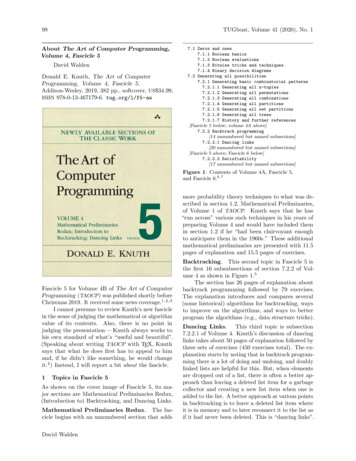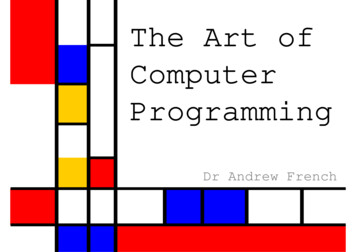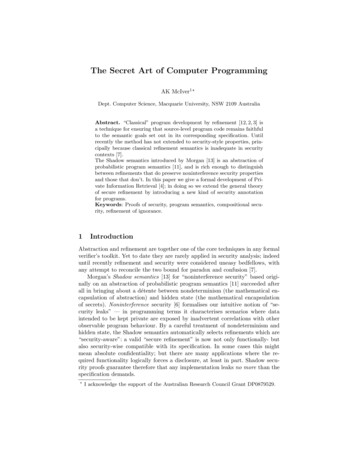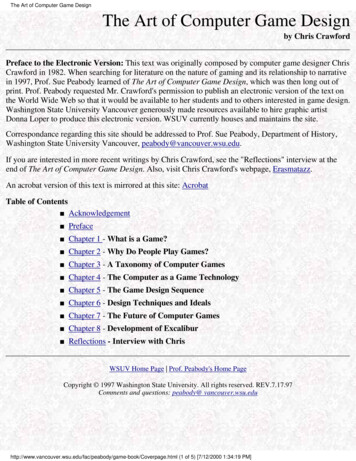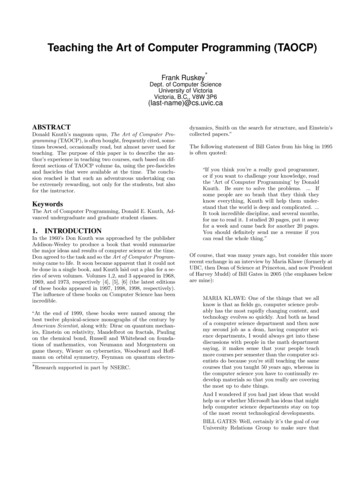
Transcription
Teaching the Art of Computer Programming (TAOCP)Frank Ruskey Dept. of Computer ScienceUniversity of VictoriaVictoria, B.C., V8W 3P6(last-name)@cs.uvic.caABSTRACTDonald Knuth’s magnum opus, The Art of Computer Programming (TAOCP), is often bought, frequently cited, sometimes browsed, occasionally read, but almost never used forteaching. The purpose of this paper is to describe the author’s experience in teaching two courses, each based on different sections of TAOCP volume 4a, using the pre-fasciclesand fascicles that were available at the time. The conclusion reached is that such an adventurous undertaking canbe extremely rewarding, not only for the students, but alsofor the instructor.KeywordsThe Art of Computer Programming, Donald E. Knuth, Advanced undergraduate and graduate student classes.1.INTRODUCTIONIn the 1960’s Don Knuth was approached by the publisherAddison-Wesley to produce a book that would summarizethe major ideas and results of computer science at the time.Don agreed to the task and so the Art of Computer Programming came to life. It soon became apparent that it could notbe done in a single book, and Knuth laid out a plan for a series of seven volumes. Volumes 1,2, and 3 appeared in 1968,1969, and 1973, respectively [4], [5], [6] (the latest editionsof these books appeared in 1997, 1998, 1998, respectively).The influence of these books on Computer Science has beenincredible.“At the end of 1999, these books were named among thebest twelve physical-science monographs of the century byAmerican Scientist, along with: Dirac on quantum mechanics, Einstein on relativity, Mandelbrot on fractals, Paulingon the chemical bond, Russell and Whitehead on foundations of mathematics, von Neumann and Morgenstern ongame theory, Wiener on cybernetics, Woodward and Hoffmann on orbital symmetry, Feynman on quantum electro Research supported in part by NSERC.dynamics, Smith on the search for structure, and Einstein’scollected papers.”The following statement of Bill Gates from his blog in 1995is often quoted:“If you think you’re a really good programmer,or if you want to challenge your knowledge, readthe ‘Art of Computer Programming’ by DonaldKnuth. Be sure to solve the problems. . Ifsome people are so brash that they think theyknow everything, Knuth will help them understand that the world is deep and complicated. .It took incredible discipline, and several months,for me to read it. I studied 20 pages, put it awayfor a week and came back for another 20 pages.You should definitely send me a resume if youcan read the whole thing.”Of course, that was many years ago, but consider this morerecent exchange in an interview by Maria Klawe (formerly atUBC, then Dean of Science at Princeton, and now Presidentof Harvey Mudd) of Bill Gates in 2005 (the emphases beloware mine):MARIA KLAWE: One of the things that we allknow is that as fields go, computer science probably has the most rapidly changing content, andtechnology evolves so quickly. And both as headof a computer science department and then nowmy second job as a dean, having computer science departments, I would always get into thesediscussions with people in the math departmentsaying, it makes sense that your people teachmore courses per semester than the computer scientists do because you’re still teaching the samecourses that you taught 50 years ago, whereas inthe computer science you have to continually redevelop materials so that you really are coveringthe most up to date things.And I wondered if you had just ideas that wouldhelp us or whether Microsoft has ideas that mighthelp computer science departments stay on topof the most recent technological developments.BILL GATES: Well, certainly it’s the goal of ourUniversity Relations Group to make sure that
we’re talking about what we think the state ofthe art problems are, finding out from the universities and a lot of dialogue back and forth aboutthat. In a certain sense, yeah, the curriculum haschanged, but say somebody came for an interviewand they said, ”Hey, I read the ’Art of ComputerProgramming’, that’s all I ever read, I did all theproblems, I would hire them right then.”MARIA KLAWE: You’d hire them right then.But I actually know of only one other course that used theArt of Computer Programming as the primary textbook;although many courses list it for supplementary reading.That one course was similar to the courses described here inthe sense that it was focussed on Volume 4, particularly inanswering the questions that Knuth asked for help on; see[2]. There have been some books devoted to other booksof Knuth, for example courses about Literate Programmingand about the MMIX architecture.BILL GATES: Yeah, that’s right.3.MARIA KLAWE: So would I.After a long hiatus, mainly devoted to the development ofTeX, Knuth resumed work on Volume 4 early in the 21st century. His modus operandi was to issue pre-fascicles whichwere approximately 100 page previews of his writing of various sections of Volume 4. Initially they were “hidden” on hiswebsite and called to the attention of selected researchers,which preceded announcement of their availability to thegeneral public. I was fortunate to be one of the ones contacted and thought that it might be interesting to fashiona course around these pre-fascicles. Knuth agreed to letme bind together various pre-fascicles, print them, and sellthem to the students at cost. I thought that this provideda unique opportunity for students to get to see a master atwork, a chance to get a glimpse at, and perhaps even beinvolved with, a piece of computer science history.BILL GATES: Even if they didn’t do the doublestar problems, I mean, just the fact that they’dread the whole book, you know, those are thekinds of things you need to know to be a goodprogrammer. Actually, there’s some of that youdon’t even need to know, but the kind of algorithmic thinking that’s promoted there.So in a sense, we want to teach the same thing,but we’d like to teach it in a forum that’s mostinteresting. So, for example, the idea of, OK,let’s take some of those basic ideas and programa robot to go somewhere or figure something out,you want to inject that into the field. But whatyou’re really teaching the person about design ispretty much the same as you wanted to teachthem 30 years ago. I mean, we still haven’t gotten past that. And so there may be rich runtimesthat we can give to universities that make surethat the person learning those things feels likethey’re doing something very cool and very interesting.Note that Gates is not saying that he would hire the personbecause they have to be extraordinarily intelligent to readTAOCP; rather it is because having read the book meansthat they have read things necessary to being a good programmer and solving problems algorthmically.The two courses that I taught are listed below. In theUVic numbering scheme a 400 level course is a 4th yearundergraduate course and a 500 level course is a graduatecourse. These websites are still active and their content canbe viewed.CSC 483A/583A F01 (2004): Knuth Volume IVhttp://www.cs.uvic.ca/ ruskey/classes/KnuthIV/.andCSC 483A/583A S01 (2009): Zeroes and Oneshttp://www.cs.uvic.ca/ ruskey/classes/ZeroesOnes/.3.1Why then aren’t we all trying to get our students toread and understand TAOCP?We will get back to this question later.2.TEACHING FROM TAOCPOk, I1 have to admit that I was indoctrinated from an earlyage. In 1973 at UCSD I took a course from Clark Crane,a student of Knuth’s. Volume 1 was the textbook. It wasa course on data structures and assembly language! E.g.,we learned about linked lists, not by implementing them insome high-level language, but rather by implementing themin MIXAL, the assembly language for Knuth’s idealized machine MIX. Such courses do not exist anymore, but I stillremember some of the problems from that course, such asKnuth’s crossword problem (1.3.2, problem 23); a delightfulproblem which I still occasionally put on homework assignments in data structures courses.1Please excuse the non-standard use of the first person hereand in the rest of the paper.THE UVIC COURSESThe Knuth Volume IV CourseThe purpose of this material was to teach the students thebasics of algorithms for exhaustively listing the combinatorial structures that most frequently occur and which havewell-understood recursive structures. Examples include multiradix numbers, permutations, combinations, set partitions,numerical partitions, necklaces, and various classes of trees.We also learned about Gray codes for many of these structures. In a Gray code listing, successive strings used in thelisting are required to differ by some small amount. For example, in the classic binary reflected Gray code for listingall subsets, each successive binary string is required to differfrom its predecessor by a bit flip in one position. Gray codelistings are a necessary condition for the development of theso-called “loopless” generation algorithms which are favoredby Knuth.The minimum pre-requisites for the course were a previouscourse on data structures and a previous course on discretemathematics; students were advised to have taken at leastone further course on theoretical computer science or combinatorics. In this course there was 1 undergraduate student
and 11 graduate students; two of the graduate students werefrom the mathematics department.read exercise N and its answer very carefully, andI believe that it is 100% correct,” where N is oneof the following:’This course covered the following topics and sections fromTAOCP Volume 4 [7]:Here is a small selection of the list that followed the abovecomment.7.2 Generating All Possibilities7.2.1 Combinatorial Generators7.2.1.1. Generating all n-tuples7.2.1.2. Generating all permutations7.2.1.3. Generating all combinations7.2.1.4. Generating all partitions7.2.1.5. Generating all set partitions7.2.1.6. Generating all trees7.2.1.7. History and further referencesThe marks were distributed 40% for homework (4 assignments), 30% for quizzes (4 20 minute in-class quizzes), and30% for a project. The students had trouble completing thequizzes in 20 minutes and on a couple of occasions I gavethem 1/2 hour.Here are some typical questions from the assignments in thatcourse. Is the solution to exercise 49 from Section 7.2.1.1 correct? If so prove it, if not provide a correct solution.This was from the first assignment. The answer wasincorrect, and I wanted to illustrate for them early onthat it was not always difficult to find an error in thesepreliminary drafts. Explain the solution to exercise 58 in 7.2.1.3. You mayassume the result of exercise 49 without explanation.Although Knuth provides solutions to all of his exercises, in many cases they are more like indications ofthe main idea needed to solve it, but many details aremissing. So an easy source of good problems is to askthem to explain a solution. Explain the last equality in equation (16) on page 29of 7.2.1.5.Here they were asked to explain something in the maintext. Knuth’s explanations are often rather terse, andso the instructor has to fill in the missing steps, orrelegate them to assignments. Develop a ranking algorithm for Algorithm H of Section 7.2.1.4. Your algorithm should be efficient (i.e.,polynomial in m and n). What is the rank of10 10 8 5 5 5 1 1?And sometimes I just made up new problems.I gave them much latitude in their project topics but encouraged them to do them on either (a) open problems mentioned in the book or (b) the specific topics that Knuth hadmentioned on his website that he wanted readers to check.Here is what he had on his website (before Volume 4a waspublished):‘Thus I would like to enter here a plea for somereaders to tell me explicitly, “Dear Don, I have 7.1.2–76 (Uhlig’s cloning algorithm, computes twice asfast as expected) 7.1.2–85 and 86 (introduction to Razborov’s monotonelower bounds) 7.1.3–124 (lower bounds on a basic RAM) 7.1.3–179 (online algorithm for components of a bitmap) 7.1.4–107 (testing whether a BDD defines a 2SAT instance) 7.2.1.3–42 (analysis of an algorithm for near-perfectcombination generation) 7.2.1.6–33 (representing binary tree links with a singlepermutation)3.2The Zeroes and Ones CourseThe purpose of this material was to teach, at a high level,basic facts about dealing with bits. First, we consideredBoolean operations and the basics of Boolean algebra andBoolean functions. Next was a consideration of circuits forimplementing Boolean functions. Then came study of howto take advantage of the fact that computers organize bitsinto words and provide operations on words. And lastlywe studied binary decision diagrams, which are often themethod of choice for representing and manipulating Booleanfunctions in a computer.In this course there were 2 undergraduate students and 10graduate students. I got a lot of grief from my colleaguesabout the title of this course; but I was just using Knuth’sown title for Section 7.1. The second course covered thefollowing topics and sections from TAOCP Volume 4 [7]:7.1 Zeros7.1.17.1.27.1.37.1.4and OnesBoolean BasicsBoolean EvaluationBitwise Tricks and TechniquesBinary Decision DiagramsMost of the time was spent in section 7.2.1, which is mainlyabout Boolean algebra and ramifications, section 7.2.2, mainlyabout Boolean circuits and their minimization, and section7.2.3, which is about various ways of taking advantage ofword operations in various algorithmic contexts. For example, in 7.2.3 you study things like X&(X 1) which turnsthe rightmost 1 in X into a 0. Knuth is often criticized forimplementing many of his algorithms in assembly languageand section 7.2.3 is rife with little pieces of assembly code forhis new machine MMIX. In this section it was particularlyhelpful to have MMIX for implementing and comparison.For example, MMIX has a SADD (population count) instruction that is not particularly easy to implement if you arerestricted to C or Java.
These were topics with which I was
The Art of Computer Programming, Donald E. Knuth, Ad-vanced undergraduate and graduate student classes. 1. INTRODUCTION In the 1960’s Don Knuth was approached by the publisher Addison-Wesley to produce a book that would summarize the major ideas and results of computer science at the time. Don agreed to the task and so the Art of Computer Program- ming came to life. It soon became





